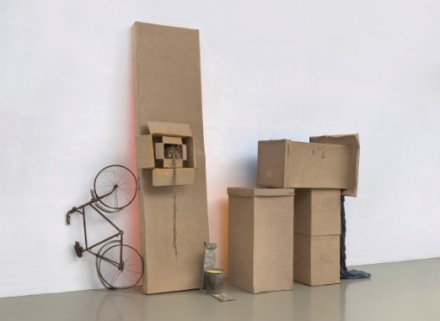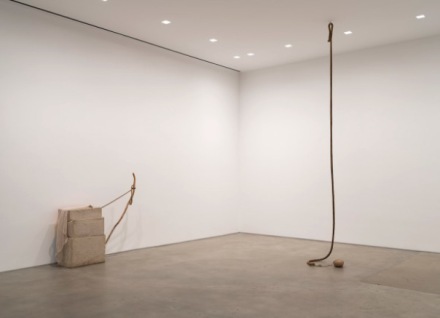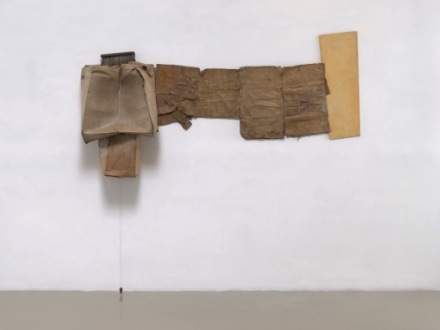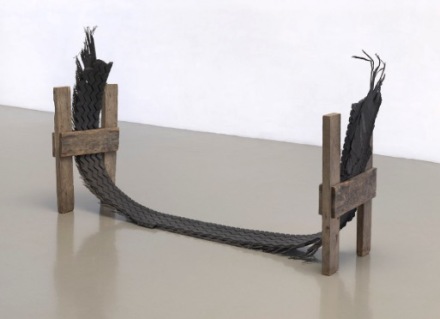
Robert Rauschenberg, Untitled (Early Egyptian) (1973), via Gladstone
Marking an expansive exploration of Robert Rauschenberg’s sculptural output at the peak of his ability, Gladstone Gallery and the Robert Rauschenberg have collaborated on a series of shows exploring his Venetian and Early Egyptians series. Spread across Gladstone’s Chelsea galleries, this show reveals Rauschenberg’s significant place in helping to define the history of post-Minimalist sculpture, seeing beyond what others decided should be the limits of art. Rauschenberg’s career was defined by the longing for work that existed beyond simple distinctions of medium, form and genre, often using found objects and collages of material to create hybridized material sites. The Venetian and Early Egyptian series blur the line between sculpture and painting, between waste and conservation, and between everyday objects and artworks.

Robert Rauschenberg, Venetians and Early Egyptians 1972 – 1974 (Installation View), via Gladstone
In 1970, Rauschenberg left New York City and relocated to the remote island of Captiva off the Gulf Coast of Florida, where he remained for nearly four decades. With the move came a new palette of readily accessible materials that embodied a shift away from motley urban density toward rural seclusion. During this time, he traveled through Italy, and was struck by the juxtaposition of the city’s grandeur and elegance, in contrast to its concurrent fragility and decay. In the works on view, Rauschenberg uses the technique of assemblage, incorporating a range of household and natural found objects, from leather and rubber, to wood utility poles and tire treads, bringing them together in strange yet poetic formations. Immersing these common objects in an artistic dimension and following the Dada and Duchampian concept of the Readymade, these works function as a point between art, life, painting, assemblage, and everything in between.

Robert Rauschenberg, Untitled (Venetian) (1973/1982), via Gladstone
In dialogue with these, he would push the concepts further with his Early Egyptian series (1973–74). Radically different from his earlier practice, these works orchestrate the no color, neutral tonalities of sand, wood, bicycle wheels, and cardboard into ascetic opulence. While imageless, viewers still encounter signature Rauschenberg objects including repurposed furniture and the tire tread he made iconic. Reflecting on cardboard’s varied historical, cultural, and economic properties, Rauschenberg shrouded and transformed the material in the Early Egyptian series. Reminiscent of his Elemental Sculptures of the 1950s, these works play with the idea of trompe l’oeil, employing cardboard, glue, and sand as analogous to stone and sediment.

Robert Rauschenberg, Untitled (Early Egyptian) (1973), via Gladstone
In Untitled (Early Egyptian) from 1974, four large rectangular boxes standing side by side are all painted a bright, reflective orange on the back, casting a colored glow on the wall behind. They are propped up by smaller cardboard boxes covered in sand, and bring to mind the Great Sphinx of Giza in form and composition. It in fact references a motif of four sun-worshipping baboons that once formed the pedestal for an obelisk in Luxor, now in the Egyptian collection of the Louvre, where Rauschenberg saw it and made this work in response. Engaging affordable and accessible material, Rauschenberg was able to create works that recall the great Egyptian temples, or in other cases, a towering angular mummy sarcophagus. Inspired by his interest in ancient Egypt, Rauschenberg transformed the cardboard material, which is associated with waste, consumerism, and labor, into luminous and precious artifacts, containers for nothing that recall so much of the past.

Robert Rauschenberg, Untitled (Venetian) (1973), via Gladstone
Marking an engagement and exploration of material in a conversation between perception and form, the show is a masterful expression of the artist’s creative vision at its peak.
The show closes June 18th.
– D. Creahan
Read more:
Robert Rauschenberg at Gladstone [Exhibition Site]



